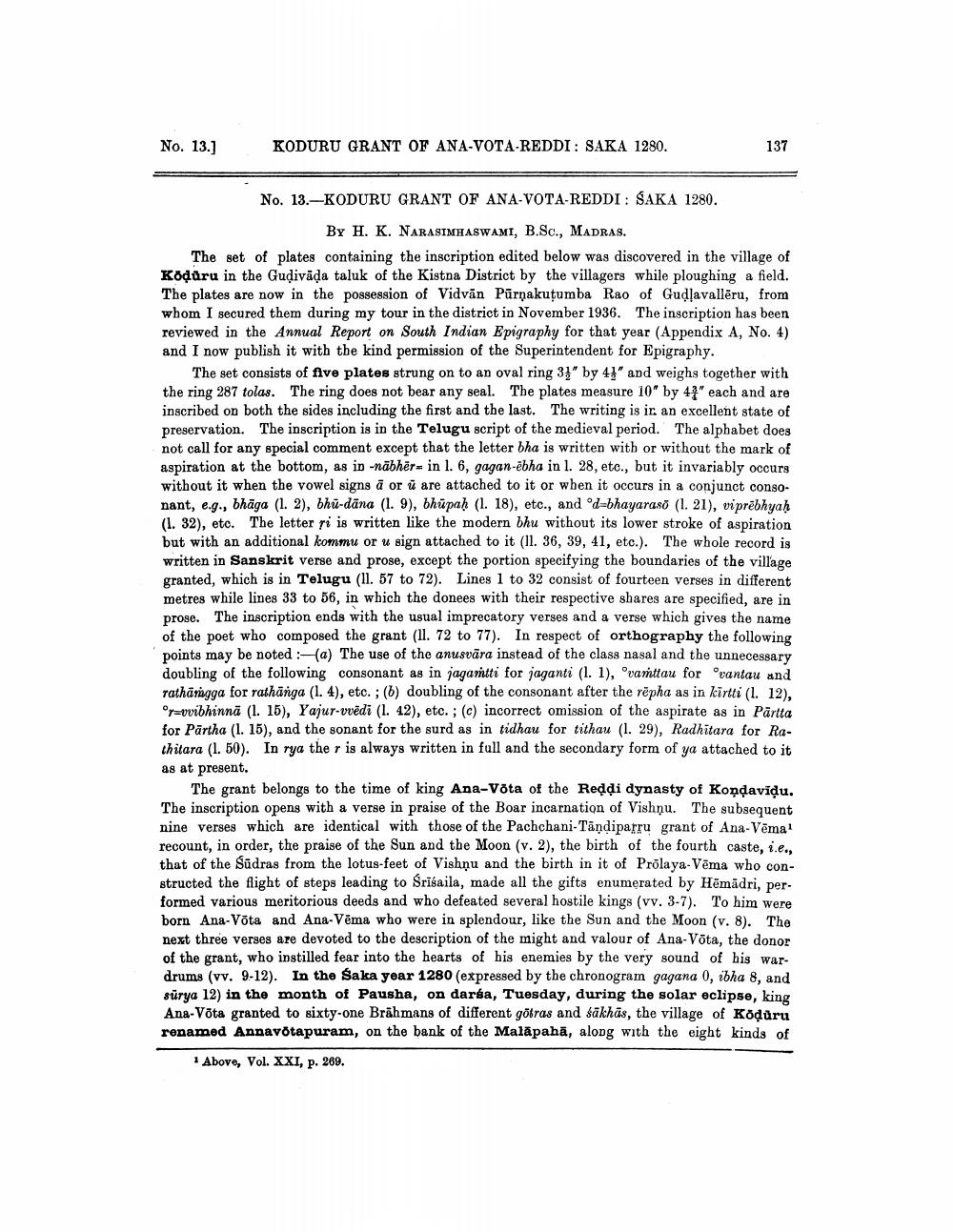________________
No. 13.]
KODURU GRANT OF ANA-VOTA-REDDI: SAKA 1280.
137
No. 13.-KODURU GRANT OF ANA-VOTA-REDDI: SAKA 1280.
By H. K. NARASIMHASWAMI, B.Sc., MADRAS. The set of plates containing the inscription edited below was discovered in the village of Kodůru in the Gudivāda taluk of the Kistna District by the villagers while ploughing a field. The plates are now in the possession of Vidvān Pūrņakutumba Rao of Gudļavallēru, from whom I secured them during my tour in the district in November 1936. The inscription has been reviewed in the Annual Report on South Indian Epigraphy for that year (Appendix A, No. 4) and I now publish it with the kind permission of the Superintendent for Epigraphy.
The set consists of five plates strung on to an oval ring 3)" by 41" and weighs together with the ring 287 tolas. The ring does not bear any seal. The plates measure 10" by 47" each and are inscribed on both the sides including the first and the last. The writing is ir an excellent state of preservation. The inscription is in the Telugu script of the medieval period. The alphabet does not call for any special comment except that the letter bha is written with or without the mark of aspiration at the bottom, as in-nābher= in 1. 6, gagan-êbha in l. 28, etc., but it invariably occurs without it when the vowel signs à or ū are attached to it or when it occurs in a conjunct consonant, e.g., bhāga (1. 2), bhu-dāna (1. 9), bhūpah (1. 18), etc., and od=bhayarasi (1. 21), viprēbhyah (1. 32), etc. The letter si is written like the modern bhu without its lower stroke of aspiration but with an additional kommu or u sign attached to it (11. 36, 39, 41, etc.). The whole record is written in Sanskrit verse and prose, except the portion specifying the boundaries of the village granted, which is in Telugu (11. 57 to 72). Lines 1 to 32 consist of fourteen verses in different metres while lines 33 to 56, in which the donees with their respective shares are specified, are in prose. The inscription ends with the usual imprecatory verses and a verse which gives the name of the poet who composed the grant (11. 72 to 77). In respect of orthography the following points may be noted : a) The use of the anusvāra instead of the class nasal and the unnecessary doubling of the following consonant as in jagamtti for jaganti (1. 1), "varttau for rantau and rathāngga for rathānga (1. 4), etc. ; (6) doubling of the consonant after the repha as in kartti (1. 12), or=vvibhinnā (1. 15), Yajur-vvēdi (1. 42), etc. ; (c) incorrect omission of the aspirate as in Pārtta for Pārtha (1. 15), and the sonant for the surd as in tidhau for tithau (1. 29), Radhitara for Rathitara (1. 50). In rya the r is always written in full and the secondary form of ya attached to it as at present.
The grant belongs to the time of king Ana-Võta of the Reddi dynasty of Kondavidu. The inscription opens with a verse in praise of the Boar incarnation of Vishnu. The subsequent nine verses which are identical with those of the Pachchani-Tandiparru grant of Ana-Vēma recount, in order, the praise of the Sun and the Moon (v. 2), the birth of the fourth caste, i.e. that of the Sūdras from the lotus-feet of Vishnu and the birth in it of Prõlaya-Vēma who constructed the flight of steps leading to Srisaila, made all the gifts enumerated by Hēmādri, performed various meritorious deeds and who defeated several hostile kings (vv. 3-7). To him were born Ana-Võta and Ana-Vēma who were in splendour, like the Sun and the Moon (v. 8). The next three verses are devoted to the description of the might and valour of Ana-Võta, the donor of the grant, who instilled fear into the hearts of his enemies by the very sound of his wardrums (vv. 9-12). In the Saka year 1280 (expressed by the chronogram gagana 0, ibha 8, and sürya 12) in the month of Pausha, on darsa, Tuesday, during the solar eclipse, king Ana-Võta granted to sixty-one Brāhmans of different götras and sākhās, the village of Kodůru renamed Annavõtapuram, on the bank of the Malāpahā, along with the eight kinds of
1 Above, Vol. XXI, p. 269.




